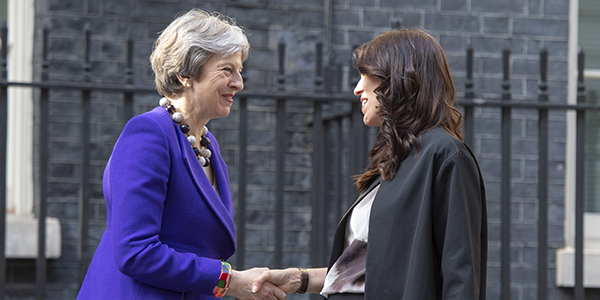Citizens (mistakenly) perceive female-led political parties as more moderate
Does women’s leadership affect citizens’ perceptions of political parties? Diana Z. O’Brien shows that female-led parties are perceived as more moderate than male-led organisations, even though election manifestos authored by these parties are actually slightly more extreme than those by male-led parties.

Theresa May meets New Zealand PM, Jacinda Ardern. Picture: Number 10/ (CC BY-NC-SA 2.0) licence
Across established democracies, the number of female-led political parties has increased markedly in recent decades. Women, for example, now head governing parties in Germany, Denmark and New Zealand (and, until recently, the United Kingdom). Women’s ascension to these highly visible positions raises an important question: does women’s leadership affect citizens’ perceptions of political parties?
In a recent article in the Journal of Elections, Public Opinion and Parties I argue that the gender of leaders influences voters’ beliefs about political parties’ left-right positions. Female-led parties are perceived as more moderate than male-led organisations. This finding holds despite the fact that manifestos authored by female-led parties are actually slightly less moderate than those forwarded by male-led organisations.
Why would citizens view female- and male-led parties differently? Existing research provides three hints. First, the public’s perception of political parties’ ideology is shaped by factors other than parties’ stated left-right positions. Voters take cues about a party’s ideological stance, for example, from who the party goes into coalition with. Second, voters have already been shown to be responsive to party leaders generally and leaders’ gender in particular. Leaders affect vote choice and survey respondents perceive that female leaders have distinct issue priorities. Third, we know that citizens hold gender stereotypes that they apply to male and female politicians. Women are viewed as more likely to compromise and to engage in consensus building.
Taken together, this work suggests that when a party has a woman in charge, citizens will draw different inferences about the left-right policy position of that party than if a man were at the helm. I test for two possible effects. First, building on research that suggests that women are seen as more cooperative and consensus-oriented, I examine whether female-led parties are viewed as more moderate than their male-led counterparts. Second, drawing on work suggesting that voters associate women with left-leaning policy issues, I test whether female-led parties are seen as more leftist than male-led organisations.
To explore the relationship between leader gender and citizens’ perceptions of party ideology, I pair information about party leaders with public opinion data on the perceived left-right position of 269 parties in 35 countries between 1976 and 2016 (1,230 party-year observations in total). Examining respondents’ average placement of parties on a left–right scale allows me to determine whether the perceived ideological location of male- and female-led parties differs.
I find a modest yet meaningful effect. Even when accounting for prior assessments of a party’s left-right location and stated policy positions, female-led organisations are viewed as more moderate/less extreme than their male-led counterparts. For more leftist parties, male-led organisations are seen as more left leaning than female-led parties. For organisations with more right-leaning platforms, male-led parties are perceived as further to the right of female-led parties that make similar policy statements. In both cases, female-led parties are seen as being more centrist.
Of course, it’s possible that female-headed parties are simply presenting more moderate policy positions to voters. This would lead respondents to assume that when a woman takes the helm the party is less extreme. To rule out this possibility, I examine parties’ actual positions on the left-right spectrum using data from the Comparative Manifestos Project. This dataset, which is based on the policy statements released by political parties before elections, is the most popular source for identifying parties’ positions on the left-right spectrum and along other policy dimensions.
I find that female-led parties are not more left or right leaning on average than their male-led counterparts. There are differences, however, in parties’ extremism (measured by the absolute value of their left-right score). But, these differences are counter to what we would expect given voters’ perceptions of party placement. On average, female-led parties are actually slightly more extreme than male-led parties.
The finding that a leader’s gender sends cues to voters, even when controlling for parties’ stated policy positions and citizens’ prior beliefs about the party, has important political implications. Gender stereotypes can sometimes advantage women, particularly if parties want to project a more centrist image. This may explain, for example, the success of female leaders in Germany’s Christian Democratic Union and France’s National Front. At the same time, assumptions about women’s moderation (and/or men’s marginally more extreme stances) may in some cases hamper women’s leadership campaigns. The perception that women are less ideologically pure may place female candidates at a disadvantage among party activists. More generally, with more women coming to the helm of political parties, it is increasingly important to consider the broader implications of women’s presence in these posts.
This article gives the views of the author, not the position of Democratic Audit. It draws on the article ‘Female leaders and citizens’ perceptions of political parties’, published in the Journal of Elections, Public Opinion and Parties.
About the author

Diana Z. O’Brien is the Albert Thomas Associate Professor of Political Science at Rice University.





 Democratic Audit's core funding is provided by the Joseph Rowntree Charitable Trust. Additional funding is provided by the London School of Economics.
Democratic Audit's core funding is provided by the Joseph Rowntree Charitable Trust. Additional funding is provided by the London School of Economics.